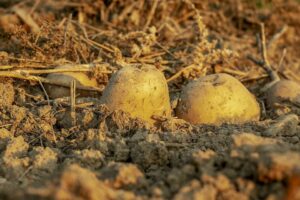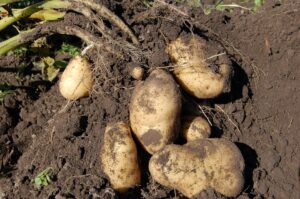Tips on when to Plant Potatoes

In our last article in case you missed it we discussed growing potatoes in grow bags, but today we will be discussing when to plant potatoes. This question has been asked so many times and we are here to give you a clearer or better understanding of the best time of the year these veggies can be planted to ensure you reap a good harvest.
It gives such a good feeling to grow and harvest your edibles (vegetables, herbs, and fruits) this was and still is both my wife and my experience when we reaped an abundance of potatoes and sweet potatoes from our home garden. This can be your experience also not to mention saving a few dollars on your grocery bills.
But before we go on I just want to throw this in, the sweet potatoes brought us such delight because after we harvested our sweet potatoes to our surprise after a few weeks we dug in the ground again and discovered more sweet potatoes which were so amazing.
3 Types of Potatoes
Potatoes can basically be divided into 3 groups or types.
1. First early potatoes- These potatoes are planted in mid-late March and ready for harvest in the months of June or July.
2. Second earlies– Plant early to mid-April, these potatoes will not be ready for harvest until mid-July or August.
3. Maincrop varieties- Plant in mid-to-late April and harvest from late August to October.
When to Plant Potatoes?
Potatoes love and thrive best in the cool not cold (winter time) weather, potatoes grow best when the days are warm and the nights are cool. Potatoes dislike the extreme summer’s heat, the ideal time to plant potatoes is 2 to 3 weeks before the last frost date.
The question is not only when but how to plant potatoes should be considered, this process can be done in 1 or 2 ways. A potato can either be planted whole if it’s small as the size of a gulf ball or if it’s a good size can be cut in two, ensure however if cutting potatoes in pieces there are at least 1 or 2 buds ( eyes) on each piece. A potato’s buds or eyes can be easily identified as sprouts on the potatoes, this is where new potatoes are formed or grows.
Bonus Points Just for Your
Avoid planting potatoes in the same spot year after year the reason for this crop rotation is to enhance the soil’s fertility, conserve soil moisture, reduce certain pest problems, increase organic matter in the soil and help to maintain the soil structures.
Before planting potatoes, lightly cultivate the soil to remove weeds, this light cultivation will lose the soil that will encourage plants to establish faster.
Slugs can become a real issue, especially when growing potatoes under black plastic.
When to Plant Potatoes?
The best time to plant potatoes as said earlier is during early spring, potatoes will not grow until the soil’s temperature reaches 45 degrees Fahrenheit. The soil should not be waterlogged but moist. To protect your potatoes from the light frost mulch lightly with straw over newly emerging potatoes, this light mulching will trap the warmth of the ground that will protect these tender plants. To extend the storage time and have a longer growing season plant a second crop in late June 15 this way you can harvest the potato as late as possible.
Preparing Your Potatoes for Planting

To get started, before a week or two of the potato’s due date to be planted, place your potatoes in an area where they can be exposed to light, and temperatures anywhere from 60-70 degrees Fahrenheit. This will encourage potatoes to begin to sprout. After about a day or two slice your potatoes into pieces with a knife that’s sharp and clean.
Each piece should be squares that are about 2 inches, each piece should also have 1 or 2 eyes or buds. Again as said earlier if potatoes are smaller than a gulf ball can be planted whole.
Getting Your Potatoes in the Ground
Now its’ planting time, it’s time to get your potatoes in the ground for a good harvest, dig a trench 6-8 inches deep. This trench however should be located in an area that gets at least 6 hours of sunlight. The soil should be loose well-drained and fertile, the soil should also be somewhat acidic with a pH range of about 5.8-6.5. Plant each potato piece with the cut side down or in the ground. The eyes should be in an upward position. Plant each piece of potato 12-15 inches and with each row giving a spacing of 3 feet apart.
Fill each trench with 4 inches of soil, when potatoes start to grow continue to fill each trench with soil and mound the soil around potatoes as they grow.
Potato Watering Methods
Throughout the summer months ensure that your potatoes are kept thoroughly watered, once flowers start to emerge continue watering even after the flowering stages because at this crucial point your potato plant is creating its tubers. Every week ensure that your potatoes get 1-2 inches of water. Once the foliage or leaves turns yellow and begins to die back discontinue watering. This will help to start the curing process of the potatoes for when it’s time to harvest.
Time to harvest your potato
After 2-3 weeks when your potatoes have finished flowering very gently dig around your potato plants to remove the potato, when digging if possible allow the smaller potatoes in the ground to remain a little longer so they can continue to grow. Only the full mature potatoes that are big should be eaten. Potatoes that are being grown for storage should not be dug up until 2-3 weeks after the leaves have died.
The use of a fork is a handy tool that will help greatly, if the weather is dry allow your potatoes to remain in the field unwashed for about 2-3 days. This curing procedure will allow the potato skin to mature along with preparing your potatoes for storage. If the weather is rainy when the time comes to harvest your potatoes to cure, locate a dry area like your porch or garage where they can remain dry while they cure.
The final word on when to plant potatoes
Planting and harvesting potatoes is that simple, following these easy but effective steps will have you eating healthy potatoes. So if your desire is to harvest potatoes from your home garden you have come to the right place for success so let’s get out there in our gardens and begin to work the soil so you can eat fresh potatoes from your garden.
About the author
Norman loves being in the garden, both at home and for his job....
he is 'Natures Little helper' being outdoors, growing his vegetables and flowers from an early age.
Now having spent over 22 years in the profession he want to give some of his knowledge to others...
his vast array of hints and tips you will find scattered over this site will help you no end growing plants in your garden.
